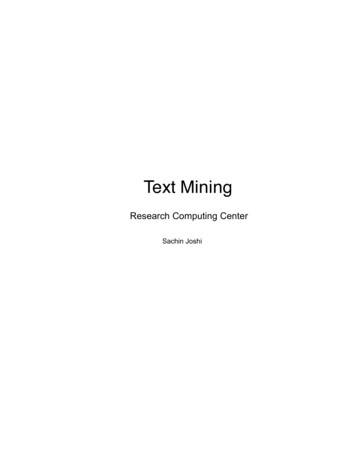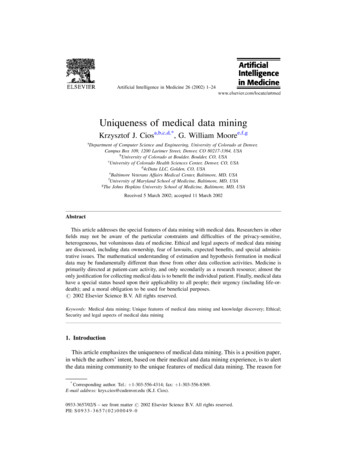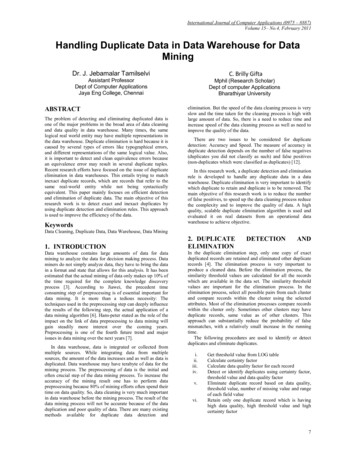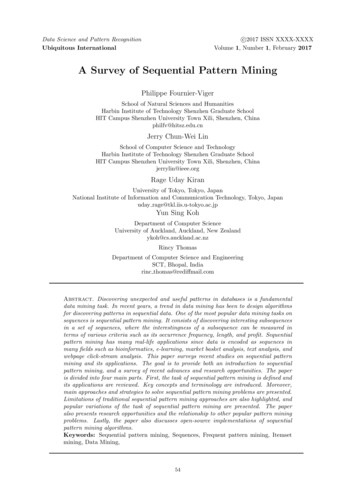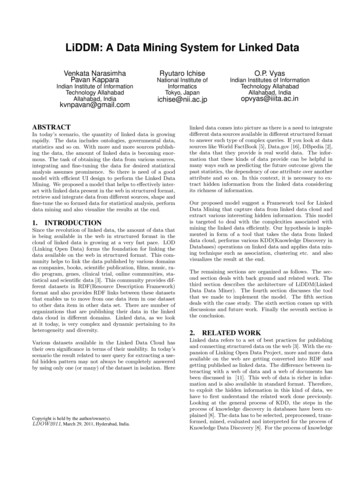
Transcription
LiDDM: A Data Mining System for Linked DataVenkata NarasimhaPavan KapparaIndian Institute of InformationTechnology AllahabadAllahabad, Indiakvnpavan@gmail.comRyutaro IchiseO.P. VyasNational Institute ofInformaticsTokyo, JapanIndian Institutes of InformationTechnology AllahabadAllahabad, Indiaichise@nii.ac.jpABSTRACTIn today’s scenario, the quantity of linked data is growingrapidly. The data includes ontologies, governmental data,statistics and so on. With more and more sources publishing the data, the amount of linked data is becoming enormous. The task of obtaining the data from various sources,integrating and fine-tuning the data for desired statisticalanalysis assumes prominence. So there is need of a goodmodel with efficient UI design to perform the Linked DataMining. We proposed a model that helps to effectively interact with linked data present in the web in structured format,retrieve and integrate data from different sources, shape andfine-tune the so formed data for statistical analysis, performdata mining and also visualize the results at the end.1.INTRODUCTIONSince the revolution of linked data, the amount of data thatis being available in the web in structured format in thecloud of linked data is growing at a very fast pace. LOD(Linking Open Data) forms the foundation for linking thedata available on the web in structured format. This community helps to link the data published by various domainsas companies, books, scientific publication, films, music, radio program, genes, clinical trial, online communities, statistical and scientific data [3]. This community provides different datasets in RDF(Resource Description Framework)format and also provides RDF links between these datasetsthat enables us to move from one data item in one datasetto other data item in other data set. There are number oforganizations that are publishing their data in the linkeddata cloud in different domains. Linked data, as we lookat it today, is very complex and dynamic pertaining to itsheterogeneity and diversity.Various datasets available in the Linked Data Cloud hastheir own significance in terms of their usability. In today’sscenario the result related to user query for extracting a useful hidden pattern may not always be completely answeredby using only one (or many) of the dataset in isolation. HereCopyright is held by the author/owner(s).LDOW2011, March 29, 2011, Hyderabad, India.opvyas@iiita.ac.inlinked data comes into picture as there is a need to integratedifferent data sources available in different structured formatto answer such type of complex queries. If you look at datasources like World FactBook [5], Data.gov [16], DBpedia [2],the data that they provide is real world data. The information that these kinds of data provide can be helpful inmany ways such as predicting the future outcome given thepast statistics, the dependency of one attribute over anotherattribute and so on. In this context, it is necessary to extract hidden information from the linked data consideringits richness of information.Our proposed model suggest a Framework tool for LinkedData Mining that capture data from linked data cloud andextract various interesting hidden information. This modelis targeted to deal with the complexities associated withmining the linked data efficiently. Our hypothesis is implemented in form of a tool that takes the data from linkeddata cloud, performs various KDD(Knowledge Discovery inDatabases) operations on linked data and applies data mining technique such as association, clustering etc. and alsovisualizes the result at the end.The remaining sections are organized as follows. The second section deals with back ground and related work. Thethird section describes the architecture of LiDDM(LinkedData Data Miner). The fourth section discusses the toolthat we made to implement the model. The fifth sectiondeals with the case study. The sixth section comes up withdiscussions and future work. Finally the seventh section isthe conclusion.2.RELATED WORKLinked data refers to a set of best practices for publishingand connecting structured data on the web [3]. With the expansion of Linking Open Data Project, more and more dataavailable on the web are getting converted into RDF andgetting published as linked data. The difference between interacting with a web of data and a web of documents hasbeen discussed in [11]. This web of data is richer in information and is also available in standard format. Therefore,to exploit the hidden information in this kind of data, wehave to first understand the related work done previously.Looking at the general process of KDD, the steps in theprocess of knowledge discovery in databases have been explained [8]. The data has to be selected, preprocessed, transformed, mined, evaluated and interpreted for the process ofKnowledge Data Discovery [8]. For the process of knowledge
discovery in the semantic web, SPARQL-ML was introducedby extending the given SPARQL language to work with statistical learning methods [12]. This imposes the burden ofhaving the knowledge of extended SPARQL and its ontology on the users. Some researches [14] have extended themodel for adding data mining method to SPARQL [18] byrelieving the burden on users to have the exact knowledge ofontological structures by asking them to specify the contextto automatically retrieve the items that form the transaction. However, ontology axioms and semantic annotationsfor the process of association rule mining have been usedearlier [14].In our approach, we modified the model used by U. Fayyadet al [8], which is general process of KDD, to suit the needsof linked data. Instead of extending SPARQL [18], we retrieved the linked data using normal SPARQL queries andinstead focused on the process of refining and weaving theretrieved data to finally transform it to be fed into the datamining module. This approach separated the work of retrieving data from the process of data mining and relievedthe users from the burden of learning extended SPARQL andits ontology. Also this separation allowed more flexibility inchoosing whatever data we needed from various data sourcesfirst and then concentrating on mining the data once all thedata needed had been retrieved, integrated and transformed.Also LiDDM works by finding classifications and clusteringin addition to finding associations.3.LIDDM: A MODELTo start with, our model modified the process of KDD, as wediscussed in the previous section to conform to the needs oflinked data and proceeded in a hierarchical manner. A datamining system was used for statistical analysis and linkeddata from the linked data cloud was retrieved, processed andfed onto it. Figure 1 provides the overview of our model.3.1Data Retrieval through QueryingIn this initial step of LiDDM, the data from linked datacloud is queried and retrieved. This step can be comparedto the data selection step in the KDD Process. The dataretrieved will be in the form of a table with some rows andcolumns. The rows denote instances of data retrieved andthe columns denote the value of each attribute for each instance.3.2Data PreprocessingOnce the data retrieval is done, data preprocessing comesinto picture which plays a significant role in data miningprocess. Most of the time data is not in a format suitablefor immediate application of data mining techniques. Thisstep highlights that data must be appropriately preprocessedbefore going for further stages of knowledge discovery.3.2.1Data IntegrationIn the previous step of Linked Data Mining, data is retrievedfrom multiple data sources existing in Linked data cloud.This allows the feasibility of having distributed data. Thisdata must be integrated in order to provide answer to user’squery. Data is integrated based on some common relationpresented in respected data sources. Data sources are selected depending on different factors a user wants to studyFigure 1: Architecture of LiDDMin different sources. For example, if we want to study theeffect of growth rate of each country on its film production,data sources selected can be the World FactBook and theLinked Movie Data Base [10]. We can first query the WorldFactBook for the growth rate of each country. Then wecan query the Linked Movie Data Base for information regarding film production of each country and now we haveto integrate both the results in order to find the answer ofrespected query.3.2.2Data FilteringIn this step, data that is retrieved and integrated is filtered.Some rows or columns or both are deleted if necessary. Filtering eliminates the unwanted and unnecessary data. Forexample, let’s consider the previous case of the World FactBook and Linked Movie Data Base. If we want the growthrate of a country to be not less than a certain minimumvalue for research purposes, we can eliminate instances withgrowth rates less than a certain minimum value at this step.3.2.3Data SegmentationThe main purpose of segmenting the data is to divide thedata in each column into some classes if necessary for statistical analysis. For example, the data in a certain range canbe placed into some class if necessary. Consider the attribute‘population of a country’. In this case, populations less than10,000,000 can be placed under the segment named ‘Lowpopulation’. Populations from 10,000,000 to 99,999,999 canbe placed under the segment named ‘Average Population’and populations from 100,000,000 to 999,999,999 can beplaced under the segment named ‘High Population’. Thestep of segmentation step divides the data into differentclasses and segments, for a class based statistical analysisat the end.
Figure 2: This UI shows the data retrieved from World FactBook and Linked Movie Data Base Integration3.3Preparing Input Data for MiningMore often than not, the format in which we retrieve thelinked data is not the correct format that is required forfeeding into the data mining system. Therefore, it is necessary to change the format to the one that is required bythe data mining system. The step does exactly this work offormat conversion. Thus, this step basically does the sameas the transformation of data part in the KDD process.3.4Data Mining on Linked DataIn this step, the data mining of the already filtered andtransformed data is performed. In this step, you can inputthe data that is in the format accepted by the data miningsystem from previous step into the data mining system foranalysis. Here the data may be classified or clustered or setfor finding association rules. After applying these methods,the results are obtained and visualized for interpretation.Thus LiDDM with all the above features, we believe, willensure a very good and easy to use framework tool not onlyfor interacting with linked data and visualizing the resultsbut also for re-shaping the data retrieved. The next sectiondeals with the implementation of our model in an application.4. IMPLEMENTATION WORK4.1 Tool EnvironmentTo test our model LiDDM, we made an application that implements it. This application was called ‘LiDDMT: LinkedData Data Mining Tool’. With this tool, we used JenaAPI [4] for querying remote data sets in the linked datacloud. Weka API [9] was used for the process of data mining. Weka is widely recognized as the unified platform forperforming most of the machine learning algorithms in asingle place. Jena is a java framework for building semanticweb applications. The tool was made using Java in a NetBeans environment.4.2Working of the ToolStep 1. This tool emulates our model in the following ways.It has a UI for querying the remote data sets. Thereare two types of querying that are allowed in this model.One is that the user can specify the SPARQL endpointand SPARQL query for the data to be retrieved. Thesecond type of querying is an automatic query builderthat reduces the burden on the user. The possibilityof using sub graph patterns for generating automaticRDF queries has been discussed [7]. Our query buildergives the user all the possible predicates he can usegiven the SPARQL endpoint and asks him to specifyonly the triples and returns the constructed query. TheDrupal Sparql Query Builder [17] also asks the user tospecify triples.Step 2. Regarding Step 2 of our model, which is integrationof data retrieved, our tool implements a UI that uses aJOIN operation to perform the JOIN of the retrievedresults from two or more queries. It also uses an ‘append at the end’ operation, which adds the results oftwo or more queries. Figure 2 shows this functionality. In this figure the text area under ‘Result-Query1’gives the results of Query 1, which is a query from
the World FactBook and the text area under ‘ResultQuery2’ gives the results of Query 2, which is a queryfrom the Linked Movie Data Base. The text areaunder ‘RESULT-CURRENT STATE AFTER MERGING BOTH THE QUERIES’ gives the result of theJOIN operation performed between the 3rd column ofquery 1 and the 3rd column of query 2 as shown inthe figure. Once merging is done, clicking the ‘Addanother Query’ button gives you the option to add athird query. Clicking ‘Continue’ takes you to Step 3.Step 3. Now moving to Step 3 of our model, our tool implements a UI, which is named ‘Filter’ that filters andcleans the data thus retrieved and integrated. This UIhas features of removing unwanted columns, deletingthe rows that have values out of a certain range in anumerical column, deleting the rows that have certainstrings in certain columns, etc.Step 4. Now after filtering the data, we move onto UI forStep 4 of our model, which is the segmentation of data.It asks for the name of the segment, and if the valuesin the column are numeric, we can specify the intervalof values that comes in that segment. If the values inthe column are string based, then we can specify theset of strings that comes in that segment. Thus our UIconverts the data into segments or classes as desiredby us for the data mining algorithms to work on it.Step 5. The UI for Step 5 of our model performs the task ofwriting the data into the format as required for mining. We used Weka in our tool, and Weka acceptsinput data in the ARFF(Artribute-Relation File Format) format [13]. Thus this UI asks for the relationname and also the values of attributes for conversionto ARFF format. Once you have finished this conversion, the linked data retrieved becomes acceptable touse for data mining applications using Weka.Step 6. Our tool has a very flexible UI for data mining(Step 6) in that it has a separate UI for using the original Weka with its full functionality. It also has a simplified version of the UI that is for quick mining wherewe have implemented the J48 decision tree classification [15], Apriori association [1], and EM (estimationmaximization) clustering [6]. Figure 3 shows the simplified version of the data mining tool. Using this UI,you can perform data mining for the ARFF file thatwas made in Step 5; also you have a file chooser thataccepts any other already formed ARFF files, whichcan also be input for mining and results can be compared and visualized at the same time. In our simplified version of the UI for mining, you can specify themost common options for each of the methods (J48,Apriori, and EM) and can cross check the results byvarying different parameters.Views of Results. The results that are output from thisstep are visualized at the end. The results from theJ48 decision tree classifier are visualized in the form ofa decision tree along with classifier output like precision recall, F-Measure etc. Similarly, the results fromEM clustering are visualized in the form of an X-Y plotwith clusters shown. The results from Apriori associ-Figure 3: This UI shows the simplified version ofdata mining tool.ation if any, can be visualized in the form of printingthe best associations found.Also as described in our model, our tool LiDDMThas forward and backward moment flexibility in Step3, Step 4 and Step 5 i.e.; in filter, segmentation andwriter, where you can get the results at any step andcan go back and forth to any other step. The sameis the case with Step 2(in the model) where even withour tool, the UI allows integration of any number ofqueries as long as they can be merged using either the‘JOIN’ operation or ‘append at the end’ operation.5.CASE STUDYOur tool LiDDMT has been tested with many datasets likeDBpedia, Linked Movie Data Base, World FactBook, Data.govetc. However, here for the process of explanation, we chooseto demonstrate the effectiveness of our tool from the experiments with the World FactBook dataset.World FactBook dataset provides information on the history,people, government, economy, geography, communicationsand other transnational issues of every country for about266 world entities. We explored this dataset and found outsome interesting patterns using our tool.First, we queried the World FactBook Database for GDP percapita, GDP composition by agriculture, GDP compositionby industry, and GDP composition by services of every country. Then in step 4, which is segmentation, we divided eachof the attributes, i.e. GDP by agriculture, industry, and services, into 10 classes each at equal intervals of 10 percent.Then GDP per capita is divided into three classes calledlow, average, and high depending on whether the value isless than 10,000, between 10,000 and 25,000, or more than25,000 respectively. This segmented data is sent as input tothe Apriori algorithm, and we found two association rulesthat have proved to be very accurate. The rules are as follows:
Figure 5: This figure shows that when labor forcefrom agriculture is low (A L), then literacy rate ishigh (L H) with a 7 percent error rate out of 68 instances. Also when labor force from agriculture ismedium (A M), then the literacy rate is high (L H)with 11 percent error rate out of 43 instances. Thusthis can signify an inverse relationship between literacy rate and labor force in agriculture.Figure 4: Here PC denotes GDP per capita andaggr-X denotes GDP composition by agriculturewhich is X percent. When the GDP per capita income is high (40 instances),the GDP composition by agriculture is between 0 to10 percent (39 instances) with a confidence of 0.98. When the GDP composition by services is between 70to 80 percent (32 instances), the GDP composition byagriculture is between 0 to 10 percent (29 instances)with a confidence of 0.91.If the same data is allowed to undergo EM clustering usingthe Step 6, the visualizations (shown in Figure 4) that areobtained also prove this fact.Then we queried the World FactBook database for literacyrate, labor force in agriculture, labor force in industry, andlabor force in services of every country. Then using step 4,which is segmentation, we segmented each of the attributesof labor force in agriculture, labor force in industry, laborforce in services into three classes namely low, medium, andhigh respectively. We segmented the literacy rate attributeinto three classes namely low, medium, and high depending on whether the literacy rate is between 0 and 50, 50 to85, and 85 to 100 respectively. Here we are comparing theeffects of labor force on each sector on the literacy rate ofthe country. Figure 5 shows the effect of labor force fromagriculture on literacy rate.We have also tested our tool by retrieving information aboutmovies from 1991 to 2001 by DBpedia and Linked MovieData Base from various countries and integrated that withdata retrieved from the World FactBook like median ageof the population and total population and found out thefollowing patterns. If the population is greater than 58,147,733 and median age is greater than 38, the movie production ishigh with a confidence of 1. If population is between 58,147,733 and 190,010,647,and median age is less than 38, the movie productionis low with a confidence of 1.Thus the above results prove that our LiDDMT is helpingus to find out hidden relationships between the attributesin linked data thereby helping effectively in Knowledge Discovery.6.DISCUSSIONS AND FUTURE WORKFrom our experiments and case study we can say that themodel that we proposed, LiDDM, has its strength in that itcan retrieve data from multiple data sources and integratethem instead of just retrieving the data from a single datasource. It can treat data from various sources in the samemanner. The preprocessing and transformation steps makeour model unique to deal with linked data. This allows usthe flexibility of choosing data at will and then concentrateson mining. Also our tool, LiDDMT, helps us to mine andvisualize data from more than one ARFF file at the sametime, thus giving us the option for comparison.By introducing graph-based techniques, triples could be foundout automatically in future. Also, currently all the availablepredicates are obtained for only DBpedia and Linked MovieData Base. For others you have to specify the predicatesyourselves without prefixes if you use the automatic querybuilder. This functionality can be extended to other datasources easily. Thus, more and more data sets can be implemented here drawing predicates from all of them. But withour tool, even though you cannot get all the available predicates for datasets other than DBpedia and Linked MovieData Base, you can use the automatic query builder to generate SPARQL queries automatically, if you know the URIof the predicate that you are using. Thus, more functionalitycan be imparted into the automatic query builder.Also in future, some artificial intelligence measures can beintroduced into LiDDM for suggesting the best machinelearning algorithms that can give the best possible resultsdepending on the data obtained from the linked data cloud.All in all, the existing functionality of the LiDDMT has been
tested with many examples and our tool is proved to be veryeffective and usable.7.CONCLUSIONSLinked data with all its diversity and complexity acts asa huge database of information in RDF format, which ismachine readable. There is a need to mine that data to finddifferent hidden patterns and also make it conceivable forpeople to find out what it has in store for us.Our model, LiDDM, successfully builds a data mining mechanism on top of linked data for effective understanding andanalysis of linked data. The features in our model are builtupon the classical KDD process and are modified to servethe needs of linked data. The step of getting the requireddata from the remote database itself makes our model dynamic. Flexibility is an added feature of our model as thesteps of data retrieval and mining are separate. This allowsusers to retrieve all the possible results first and then todecide on the mining techniques. Also, the smooth cyclicmovement in Step 3, Step 4, and Step 5, i.e. filter, segmentation, and writer respectively, makes our model moreadaptable and more inclined towards removal of unwanteddata and finding richer patterns. Visualizations at the endsolve our problem by pictorially representing the interestingrelationships hidden in the data there by making the datamore understandable.Regarding our tool, LiDDMT which we built on top of ourmodel, the functioning is effective and the results are efficient as shown in case studies. Using Weka in our toolfor the process of data mining makes it more efficient considering the vast popularity of Weka. The tool has muchfunctionality implemented at each step of our model in aneffort to make it more dynamic and usable. Also, having achance to view more than one visualization at a time whenimplementing more than one data mining method makes ourtool a very suitable one to compare data. But still the toolcould be made more efficient as we discussed in the previoussection.8.REFERENCES[1] R. Agrawal and R. Srikant. Fast algorithms for miningassociation rules in large databases. In Proceedings ofthe 20th International Conference On Very Large DataBases, pages 487–499, San Francisco, Ca., USA, Sept.1994. Morgan Kaufmann Publishers, Inc.[2] S. Auer, C. Bizer, G. Kobilarov, J. Lehmann,R. Cyganiak, and Z. Ives. DBpedia: A nucleus for aweb of open data. In Proceedings of the 6thInternational Semantic Web Conference, volume 4825of Lecture Notes in Computer Science, pages 722–735,Busan, Korea, Nov. 2007.[3] C. Bizer, T. Heath, and T. Berners-Lee. Linked data the story so far. International Journal on SemanticWeb and Information Systems, 5(3):1–22, 2009.[4] J. J. Carroll, I. Dickinson, C. Dollin, D. Reynolds,A. Seaborne, and K. Wilkinson. Jena: implementingthe semantic web recommendations. In Proceedings ofthe 13th International World Wide Web Conferenceon Alternate Track Papers & Posters, pages 74–83,New York, NY, USA, 2004. ACM.[5] Central Intelligence Agency. The world the-worldfactbook/,2011.[6] A. P. Dempster, N. M. Laird, and D. B. Rubin.Maximum likelihood from incomplete data via the EMalgorithm. Journal of the Royal Statistical Society,39:1–38, 1977.[7] J. Dokulil and J. Katreniaková. RDF query generator.In Proceedings of the 12th International Conference onInformation Visualisation, pages 191–193. IEEEComputer Society, 2008.[8] U. Fayyad, G. Piatetsky-Shapiro, and P. Smyth. TheKDD process for extracting useful knowledge fromvolumes of data. Communications of the ACM,39(11):27–34, Nov. 1996.[9] M. Hall, E. Frank, G. Holmes, B. Pfahringer,P. Reutemann, and I. H. Witten. The WEKA datamining software: an update. SIGKDD Explorations,11(1):10–18, 2009.[10] O. Hassanzadeh and M. Consens. Linked movie database. In Proceedings of the Linked Data on the WebWorkshop, 2009.[11] T. Heath. How will we interact with the web of data?IEEE Internet Computing, 12(5):88–91, 2008.[12] C. Kiefer, A. Bernstein, and A. Locher. Adding datamining support to SPARQL via statistical relationallearning methods. In Proceedings of the 5th EuropeanSemantic Web Conference, volume 5021 of LectureNotes in Computer Science, pages 478–492. Springer,2008.[13] Machine Learning Group at University of Waikato.Attribute-relation file format.http://www.cs.waikato.ac.nz/ ml/weka/arff.html,2008.[14] V. Nebot and R. Berlanga. Mining association rulesfrom semantic web data. In Proceedings of the 23rdInternational Conference on Industrial, Engineering &Other Applications of Applied Intelligent Systems,volume 6097 of Lecture Notes in Computer Science,pages 504–513. Springer Berlin / Heidelberg, 2010.[15] J. R. Quinlan. C4.5: Programs for Machine Learning.Morgan Kaufmann, San Mateo, CA, 1993.[16] the United States Government. Data.gov.http://www.data.gov/, 2011.[17] C. Wastyn. Drupal sparql query builder.http://drupal.org/node/306849, 2008.[18] E. PrudŠhommeaux and A. Seaborne. SPARQLQuery Language for RDF. In W3C WD,4th October,2006. 004
3.4 Data Mining on Linked Data In this step, the data mining of the already filtered and transformed data is performed. In this step, you can input the data that is in the format accepted by the data mining system from previous step into the data mining system for analysis. Here the data may be classified or clustered or set






